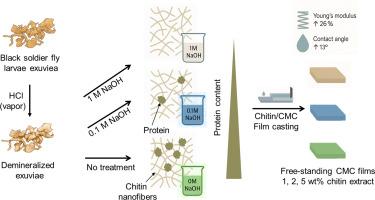Structure-property relationships in minimally processed insect chitin/carboxymethyl cellulose films
IF 12.5
1区 化学
Q1 CHEMISTRY, APPLIED
引用次数: 0
Abstract
Polymers from renewable resources, e.g., polysaccharides, can decarbonize the materials sector and transform the dominant linear carbon-intensive economies into sustainable biobased models. Chitin – conventionally isolated from crustaceans – enables multiple advances in carbohydrate science. Here, we studied insect exuviae as an emerging source of chitin, and explored how different top-down isolation processes affected its structure and physicochemical properties. NaOH-treatment predominantly removed proteins, allowing control over the chitin-to-protein ratio. The chitin was used to reinforce a model biobased polymer, carboxymethyl cellulose (CMC). Free-standing films containing 1, 2 and 5 wt% chitin were fabricated by aqueous dispersion and doctor-blade casting. The mechanical reinforcing effect was greater for minimally processed insect chitin, where 1 wt% minimally-processed chitin, a protein rich material (14–20 wt%), increased the Young's modulus by 26 %, from 1750 ± 220 MPa for the neat CMC to 2210 ± 190 MPa for the composite. Conversely, higher purity chitin obtained from 1 M NaOH (1–5 wt% protein) increased the elastic modulus by 11 %. Chitin also improved surface hydrophobicity and film opacity, evaluated across chitin concentration in CMC films and treatment severity, totaling nine samples. This research underscores the promise of insect-derived chitin and minimal biomass processing for sustainable yet competitive polymeric materials from renewable carbon.

最低加工昆虫几丁质/羧甲基纤维素薄膜的结构-性能关系
来自可再生资源的聚合物,如多糖,可以使材料部门脱碳,并将占主导地位的线性碳密集型经济转变为可持续的生物基模式。几丁质——通常是从甲壳类动物中分离出来的——使碳水化合物科学取得了多项进展。本研究以昆虫蜕皮为研究对象,探讨了不同的自上而下分离工艺对其结构和理化性质的影响。naoh处理主要去除蛋白质,允许控制几丁质与蛋白质的比例。甲壳素用于增强模型生物基聚合物羧甲基纤维素(CMC)。采用水分散和医生叶片铸造法制备了含有1、2和5 wt%甲壳素的独立薄膜。昆虫甲壳素的机械增强效果更大,其中1 wt%的极少量加工甲壳素,一种富含蛋白质的材料(14-20 wt%),使杨氏模量增加26%,从纯CMC的1750±220 MPa增加到复合材料的2210±190 MPa。相反,从1m NaOH (1 - 5 wt%蛋白质)中获得的高纯度甲壳素使弹性模量增加了11%。甲壳素还改善了CMC膜的表面疏水性和膜的不透明度,评估了CMC膜中的甲壳素浓度和处理严重程度,共9个样品。这项研究强调了昆虫来源的几丁质和最小的生物质加工的前景,这些生物质加工可以从可再生碳中获得可持续且具有竞争力的聚合物材料。
本文章由计算机程序翻译,如有差异,请以英文原文为准。
求助全文
约1分钟内获得全文
求助全文
来源期刊

Carbohydrate Polymers
化学-高分子科学
CiteScore
22.40
自引率
8.00%
发文量
1286
审稿时长
47 days
期刊介绍:
Carbohydrate Polymers stands as a prominent journal in the glycoscience field, dedicated to exploring and harnessing the potential of polysaccharides with applications spanning bioenergy, bioplastics, biomaterials, biorefining, chemistry, drug delivery, food, health, nanotechnology, packaging, paper, pharmaceuticals, medicine, oil recovery, textiles, tissue engineering, wood, and various aspects of glycoscience.
The journal emphasizes the central role of well-characterized carbohydrate polymers, highlighting their significance as the primary focus rather than a peripheral topic. Each paper must prominently feature at least one named carbohydrate polymer, evident in both citation and title, with a commitment to innovative research that advances scientific knowledge.
 求助内容:
求助内容: 应助结果提醒方式:
应助结果提醒方式:


